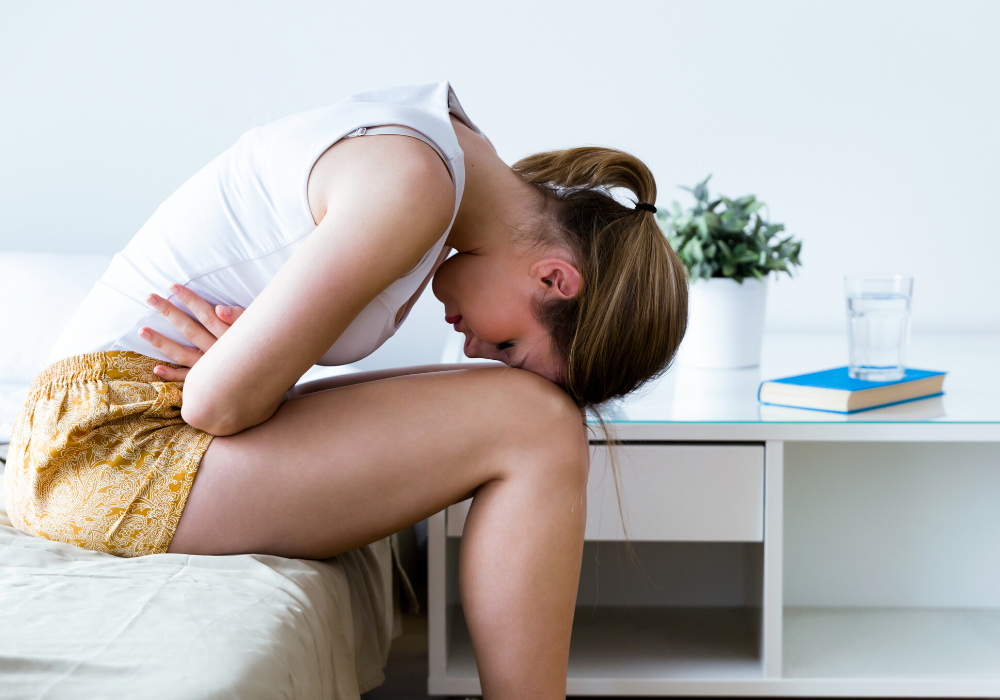
If you think only older women develop ovarian cysts, think again. Ovarian cysts can occur at any age and are far more common than you think. There are many types of ovarian cysts, and while they might sound scary and uncomfortable, most women who have them do not experience any abdominal pain or pelvic pain. It is, however, important to monitor ovarian cysts in case of complications such as cyst ruptures.
If you are concerned about developing ovarian cysts, regular pelvic exams can help detect the signs and symptoms of ovarian cysts and can provide medical advice to protect your personal and reproductive health overall. The Tidewater Physicians for Women team is ready to help keep you healthy and well.
What is an Ovarian Cyst?
Cysts are fluid-filled sacs inside or on the surface of the ovaries. Women have two ovaries, one on each side of the uterus, and each is about the same size and shape as an almond. The ovaries exist to develop and mature eggs, which are released every month of a woman’s childbearing years during ovulation as part of your normal menstrual cycle, then are shed during menstruation if unfertilized. This cycle continues until menopause.
You can develop ovarian cysts naturally, and they are quite common. Most of the time, they cause little to no discomfort and are entirely harmless. In most cases, they clear up on their own and do not require treatment. Sometimes, however, ovarian cysts can twist or rupture, which can cause serious and even life-threatening symptoms. This is why it is so important to visit your gynecologist healthcare provider regularly for pelvic exams and to be familiar with the signs that let you know when you are at risk.
Most ovarian cysts are relatively small and do not cause symptoms. They are often found during a routine pelvic exam or imaging test.
Cysts that come with symptoms may cause a dull or sharp ache in the abdomen, bloating, swelling, and pain during certain activities. Larger cysts may cause twisting of the ovary, which causes pain on one side that comes and goes. Cysts that bleed or burst can cause sudden, severe pain.
You may want to consider going in for annual exams with your OBGYN to ensure everything is healthy.
What Are the Different Types of Ovarian Cysts?
The major types of cysts are functional, which are naturally occurring and necessary to your body, and other types of cysts unrelated to menstrual cycles. Functional cysts result from natural growths called follicles, which produce estrogen and progesterone, and when they break open, they release eggs for ovulation. The two types of functional ovarian cysts are follicular cysts and corpus luteum cysts. Other types of cysts, unrelated to your menstrual cycle, are benign neoplastic cysts such as dermoid cysts, cystadenoma, endometriomas, and malignant cysts.
Follicular Cysts
Follicular cysts occur when the follicle fails to release its egg. When the follicle does not rupture to start ovulation, it continues to grow into a cyst.
Corpus Luteum Cysts
Corpus luteum cysts occur after a follicle releases its egg. At this point, the follicle is supposed to shrink and start producing estrogen and progesterone, which are essential during pregnancy. The follicle at this point is called the corpus luteum. When the egg gets blocked, and fluid backs up inside the corpus luteum, it becomes a cyst.
Benign Neoplastic Cysts (Dermoid Cysts)
Dermoid cysts are also called teratomas. They are the most common type of benign neoplastic cysts. They form when reproductive cells, called germ cells which make eggs, misbehave. These cysts can contain hair, skin, and even tooth tissue. They are rarely cancerous.
Cystadenoma
Cystadenoma develops on the surface of the ovaries and could be filled with mucous or a watery liquid. They can grow very large and may cause discomfort.
Endometrioma
Endometriomas are cysts that arise as a consequence of endometriosis. Endometriosis is a condition where cells, like those inside the uterus, begin to grow outside the uterus. When this happens, some of this tissue can attach to one of the ovaries and become a cyst called an endometrioma.
Malignant Cysts
As stated above, the vast majority of cysts are benign and can clear up naturally, but any cyst carries the risk of becoming malignant or cancerous. Malignant cysts are also called tumors and are an indication of ovarian cancer. Cysts are considered malignant if certain characteristics are present during a medical examination by your healthcare provider, from an unusual ultrasound, or when the patient has a family history of cancer. Biopsy or removal are the next steps if a cyst is potentially malignant.
What Are the Causes of Ovarian Cysts?
Polycystic Ovarian Syndrome (PCOS)
Polycystic ovary syndrome, or PCOS, is a hormonal problem that occurs during a woman’s reproductive years. Symptoms of PCOS include irregular periods, either periods that do not happen very often or those that can last for much longer than usual. Some women who have PCOS have too much androgen in their body. During this disorder, many cysts develop around the ovary, which are failed follicles. Weight loss can help to manage this condition, as can early diagnosis and medical treatment.
Weight Gain
Weight gain, as mentioned above, can be a risk factor for polycystic ovary syndrome. This is one of the risk factors that can be managed through a healthy diet, exercise, and medical advice from women’s health and wellness clinics. Healthy weight loss can help to control the risk of cysts.
What Are Some Natural Remedies for Ovarian Cysts?
In many cases, home remedies for ovarian cysts can help to manage any symptoms you might have. Your doctor may suggest any of these home remedies, including heat therapy, warm baths, to help with pain management.
Heat Therapy
Sometimes, a simple heating pad can help to ease symptoms of menstrual cramping and cyst pain. The doctor will likely recommend applying your heating pad or hot water bottle to your abdomen, indicating that it may be as effective as over-the-counter pain medication. You can make your own heating pad using a hand towel, a plastic zipper bag, and a microwave. Just soak the towel, stick it in the bag, place it in the microwave with the bag open for 2 minutes, seal it up and wrap it in another damp towel.
Warm Baths
Warm baths work the same as heat therapy. It can ease cramping and cyst pain and relax your muscles. Try adding some magnesium sulfate to the water to make the bath even more effective. Magnesium sulfate is also known as Epsom salts, which can be found at major grocery stores, your local pharmacy, or a discount store.
How Long Does an Ovarian Cyst Take to Go Away?
Without any complications, an ovarian cyst usually takes one to three months to go away. Some resolve quicker, while others take longer. Usually, this happens naturally, without treatment necessary.
Can Ovarian Cysts Become Cancerous?
While rare, ovarian cysts can be cancerous, especially among post-menopausal women. Pathological ovarian cysts can potentially cause ovarian cancer, and underlying conditions like endometriosis can also increase the risk of cancer growth. Different types of cancer can develop, depending on where the cancer began. The most common is the epithelial ovarian tumor, which starts outside the ovaries.
Signs of ovarian cancer include pelvic pain and abdominal discomfort, bloating, loss of appetite and feeling full, issues with bowel movements, frequent need to urinate, pain during sex, abnormal menstrual periods, vomiting, and fever.
When Should I Seek Medical Treatment for Ovarian Cysts?
The vast majority of ovarian cysts are harmless. If the cyst ruptures or you experience any of the symptoms above, you should seek medical attention immediately. If you know you have a cyst, inform the doctor to help them make a diagnosis.
The doctor will ask about your medical history and symptoms and conduct a physical and pelvic examination. You may need additional tests to rule out appendicitis, kidney stones, or ectopic pregnancy.
Surgery may be recommended if the cyst is large or if cancer is suspected. The type of surgery performed depends on several factors: how large the cyst is, the age of the patient, if she desires to have children, and the existence of a family history of ovarian or breast cancer.
If the cyst is benign, minimally invasive surgery is recommended and done using a small incision and a laparoscope. Open surgery may be used if cancer is suspected or if the cyst is too large to be removed with laparoscopy. Open surgery requires a larger incision that is made horizontally or vertically on the lower abdomen.
Signs of a Ruptured Cyst
Many of the signs of a ruptured cyst are similar to those of cancerous cysts. A major symptom of ruptured cysts includes sudden and severe abdominal pain. This is the most common and immediate indicator. Other signs include feeling cold, rapid breathing, weakness, lightheadedness, and clammy skin. Some women may experience pain in the lower back instead of or in addition to abdominal pain. If you experience any of these symptoms, talk to a doctor immediately.
We offer women’s wellness exams, family planning, health and wellness counseling, pregnancy assessment and care, maternity care, and expert treatment and diagnosis of reproductive system ailments such as ovarian cysts. From young teens to post-menopausal women, we are here to help you with your unique health and wellness issues and be by your side whole way. Call us at 757-461-3890 to schedule an appointment.

Written By Tidewater Physicians For Women


828 Healthy Way Unit 330
Virginia Beach, VA 23462
Fax: 757-467-0301
844 Kempsville Road #208
Norfolk, VA 23502
Fax: 757-461-0836
Appointments:
757-461-3890
Inquiries:
757-461-3890
Notice of Privacy Practices
Notice of Financial Policies

© Tidewater Physicians for Women